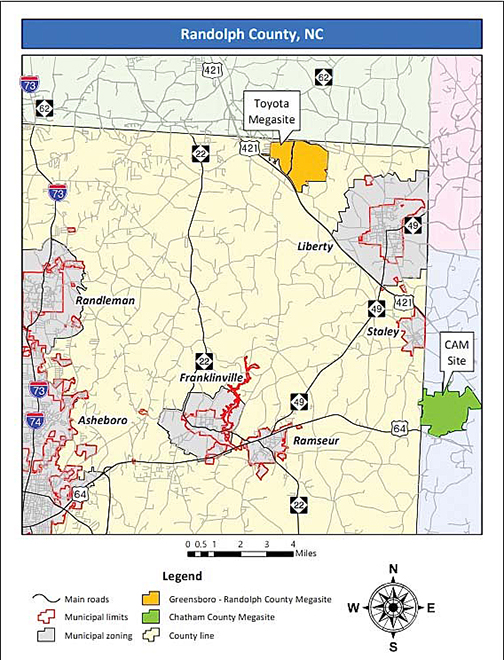Welcome!

This map of northeastern Randolph County highlights the megasites in orange and green as well as the municipality zoning areas in gray. Randolph County
County kicks off Growth Management Plan update sessions
ASHEBORO — With the coming of the Toyota Battery Plant near Liberty and Wolfspeed in Chatham County, Randolph County is in the process of updating its Growth Management Plan (GMP).
On Dec. 5, the county commissioners approved a contract with the Piedmont Triad Regional Council (PTRC) to lead the process during the next few months, to ensure that the anticipated growth in the northeastern portion of the county is a balance among sustainable economic growth, environmental protection and rural quality of life.
On Jan. 19, Jesse Day, planning director of PTRC, led the kickoff meeting of the GMP Steering Committee, composed of:
— Two county commissioners.
— Representatives of five municipalities connected with the northeast quadrant.
— Randolph County manager.
— Three members of the Randolph County Planning Board.
— Director of the Piedmont Triad Regional Water Authority.
— Randolph County’s Environmental Health director.
Support is offered by PTRC staff members and members of the county staff.
County Manager Hal Johnson welcomed the group attending the meeting at the Historic 1909 Courthouse. He said that in his many years at with the county, he didn’t think anything has had the growth impact envisioned by the additions of Toyota and Wolfspeed, expected to add 4,000-5,000 new jobs.
Dealing with the growth will involve not only the county but the municipalities of Asheboro, Randleman, Liberty, Staley, Ramseur and Franklinville.
As for updating the county’s GMP, Johnson said it would be a policy guide, not a zoning ordinance. “It will be something to use in zoning matters. We want to be proactive about land uses and think about long-range needs.” That will include the expected population growth and the challenges that will bring.
For that reason, the GMP process will seek input and feedback from all sources, including the public. Johnson defined the role of the steering committee as keeping things on track to make sure the process is going “where we want to be.”
Day led a discussion on the objectives of the GMP process. He sought answers for questions such as:
— Should there be new objectives set in the Growth Management Plan?
— Is growth/development creating additional concerns that affect Randolph County?
— Does the plan need to address overriding concerns?
— What do you like most about living in Randolph County?
— At the end of this process, what would you consider a success?
There were concerns from committee members about protecting agriculture and farmland. One member noted that agriculture is an important part of the economy.
Mayor Karen Scotton said that not everyone is “excited about growth,” adding that the updated GMP should “make sure we’re protecting citizens that are not excited about growth. There needs to be a balance.”
County commissioner David Allen said, ‘There are going to be winners and there are going to be losers. But we should own the plan, not be subjected to it.”
As far as controlling growth in the county, commission chair Darrell Frye asked, “How much is too much? Where do we stop?”
County finance officer Will Massie added, “How do you manage change when quality of life is different for different people?”
Day responded, saying that there are “a lot of unknowns,” including infrastructure improvements balanced with farm protection. He said that while the process is “in flux now, the more we know over the next six months will be helpful. The objectives are good. It’s how to get there.”
Ken Austin, member of the Planning Board, said, “Communication with the general public is vital. Something we need to address is how to keep the public informed. Word of mouth leads to rumors.”
Greg Patton, Randleman interim city manager, reminded everyone that “we’re all in it together. We’re going to see the benefits of this.”
The initial meeting was meant to outline what the process will cover. The timeline through August includes five more meetings of the steering committee, two public meetings, five municipal meetings and a final presentation to the commissioners at their September meeting.
